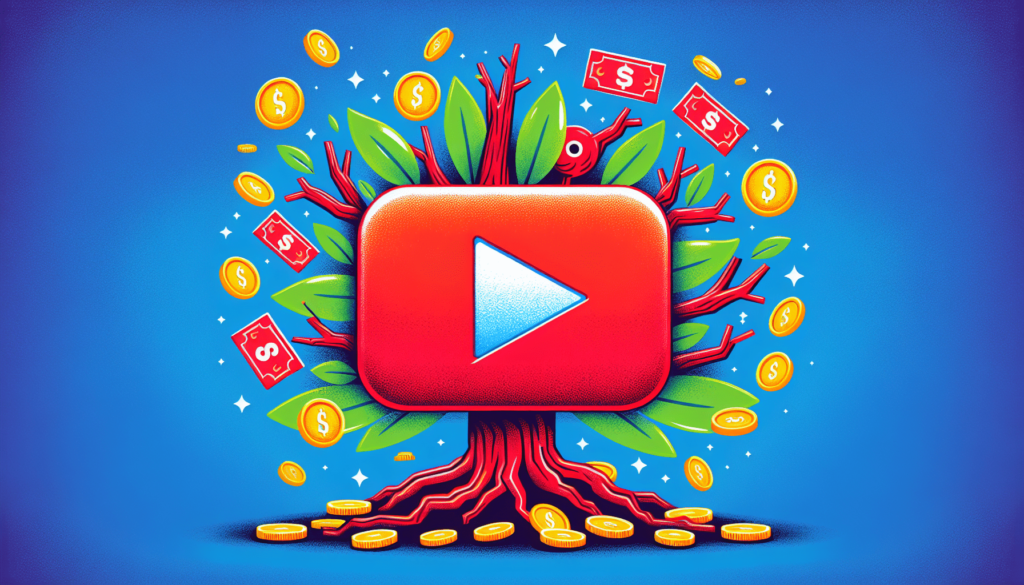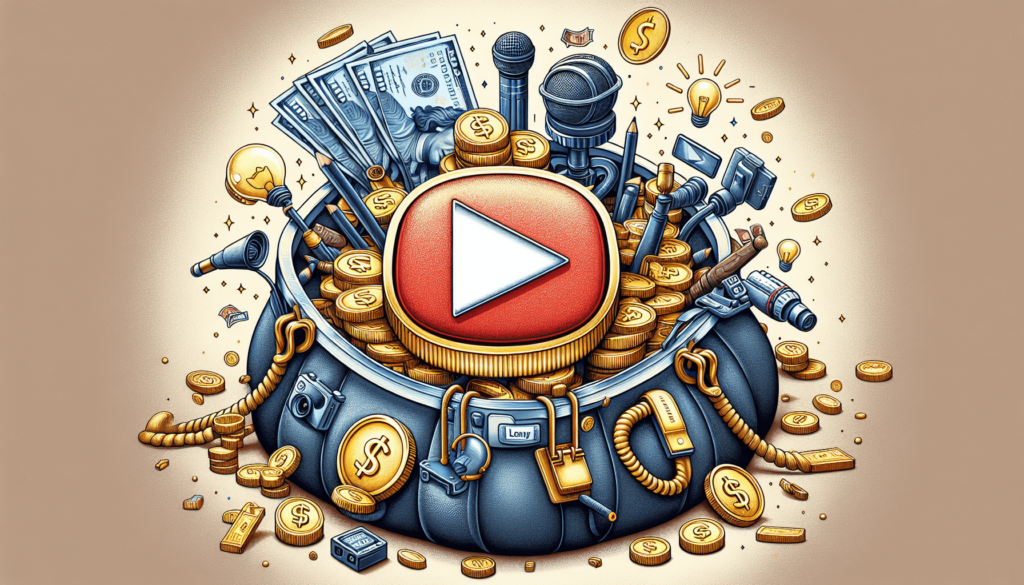If you’re looking to make money from your YouTube channel, you’ve come to the right place! Monetizing your channel can not only turn your viewers into a loyal audience but also generate a steady income stream. One of the first steps you should take is setting up AdSense, as it allows you to generate revenue through ads displayed on your videos. Additionally, you can explore affiliate marketing to earn commissions by promoting products and services, or even seek out sponsorships for brand collaborations. The key to success lies in effective strategies such as diversifying revenue streams, optimizing video content, boosting viewer engagement, and promoting your channel through various channels. By staying up-to-date with industry trends and continuously adapting your content, you can ensure long-term success in monetizing your YouTube channel. Monetizing your YouTube channel can turn your views into a steady income stream. Whether you’re a content creator or aspiring vlogger, there are several strategies you can implement to start earning money from your channel. In this comprehensive guide, we will walk you through the step-by-step process of setting up AdSense, exploring affiliate marketing, collaborating with brands for sponsorships, diversifying your revenue streams, optimizing your video content, boosting viewer engagement, promoting your channel, monitoring relevant metrics, and staying up-to-date with industry trends.

Set up AdSense
Create a Google AdSense account
The first step in monetizing your YouTube channel is to create a Google AdSense account. AdSense is a program that allows you to display targeted ads on your videos and earn money from them. To create an AdSense account, simply visit the AdSense website and follow the instructions to sign up. You will need to provide some personal information and agree to the terms and conditions of the program.
Link your AdSense account to your YouTube channel
Once you have created your AdSense account, you need to link it to your YouTube channel. This will allow YouTube to track your earnings and pay you accordingly. To link your AdSense account, go to the “Monetization” section of your YouTube Studio dashboard and follow the prompts to connect your AdSense account. Make sure to carefully follow the instructions and provide the necessary information to complete the process successfully.
Enable monetization on your channel
After linking your AdSense account, you can enable monetization on your YouTube channel. This will enable ads to appear on your videos and allow you to start earning money. To enable monetization, go to the “Monetization” section of your YouTube Studio dashboard and click on the “Enable” button. You may need to meet certain requirements, such as having at least 1,000 subscribers and 4,000 watch hours in the past 12 months, before you can enable monetization.
Set up ad formats and placements
Once you have enabled monetization, you can set up ad formats and placements on your videos. YouTube offers various types of ads, including skippable video ads, non-skippable video ads, overlay ads, and display ads. You can choose which ad formats to enable and where to place them within your videos. Experimenting with different ad formats and placements can help you find the optimal balance between maximizing revenue and maintaining a positive viewer experience.
Explore Affiliate Marketing
Research affiliate marketing programs and networks
Affiliate marketing is another effective way to monetize your YouTube channel. It involves promoting products or services and earning a commission for each sale or referral that you generate. To get started with affiliate marketing, you need to research and join affiliate marketing programs and networks. There are numerous platforms available, such as Amazon Associates, ClickBank, and Commission Junction, that offer a wide range of products and services for you to promote.
Choose products or services that align with your niche
When selecting affiliate products or services to promote, it is important to choose ones that align with your channel’s niche and audience interests. Promoting products or services that are relevant to your content will increase the likelihood of your audience engaging with your affiliate links and making purchases. For example, if you have a beauty channel, you can promote makeup products, skincare routines, or beauty subscriptions.
Promote affiliate links in your video descriptions
To incorporate affiliate marketing into your YouTube videos, you can include affiliate links in your video descriptions. You can provide a brief description or a recommendation of the product or service and include your affiliate link for viewers to make a purchase. Make sure to disclose that the link is an affiliate link to maintain transparency with your audience. It’s also a good idea to periodically review and update your affiliate links as products and promotions change over time.
Track and optimize your affiliate marketing efforts
To ensure the success of your affiliate marketing efforts, it is crucial to track and optimize your performance. Most affiliate marketing programs and networks provide tracking tools and analytics that allow you to monitor clicks, conversions, and earnings. By analyzing the data, you can identify which products or services are generating the most revenue and adjust your promotional strategies accordingly. Experimenting with different marketing techniques can help you optimize your affiliate marketing efforts and increase your earnings.
Collaborate with Brands for Sponsorships
Identify brands that align with your channel’s values
Collaborating with brands for sponsorships is an excellent way to monetize your YouTube channel while showcasing products or services to your audience. When seeking sponsorship opportunities, it is essential to identify brands that align with your channel’s values and resonate with your audience. Partnering with brands that genuinely interest you and align with your content will make your sponsorships more authentic and engaging.
Reach out to brands with a compelling pitch
Once you have identified potential sponsorships, you can reach out to brands with a compelling pitch. Your pitch should highlight the unique value you can offer to the brand, such as your audience demographics, engagement rates, and past successful brand collaborations. Consider creating a media kit that includes relevant statistics and information about your channel to present a professional and persuasive pitch.
Negotiate sponsorship terms including payment and deliverables
When negotiating sponsorship terms, it is crucial to clearly define the deliverables and payment arrangements. The deliverables may include creating dedicated sponsored videos, featuring products in your videos, or promoting the brand on your social media platforms. Discuss the scope of the sponsorship, the duration of the partnership, and any exclusivity agreements. Agree upon the payment terms, whether it’s a flat fee, a commission, or a combination of both.
Ensure disclosure and transparency in sponsored content
To maintain trust with your audience, it is essential to disclose sponsored content properly. YouTube’s guidelines require creators to clearly disclose any paid promotions or sponsorships in their videos and video descriptions. Include a disclosure statement at the beginning of your video and state in the description that the video contains sponsored content. Maintaining transparency with your audience will not only comply with platform regulations but also build credibility and trust among your viewers.
Diversify your Revenue Streams
Create and sell merchandise related to your channel
Creating and selling merchandise related to your channel can be an effective way to diversify your revenue streams. Capitalize on your brand and audience engagement by designing and selling branded merchandise such as t-shirts, hoodies, stickers, or accessories. There are numerous print-on-demand services available that handle production, inventory management, and shipping, making it easy for you to launch an online merchandise store.
Offer premium content or exclusive membership
Consider offering premium content or exclusive membership to your audience as a way to generate additional revenue. Premium content can include behind-the-scenes footage, bloopers, extended interviews, or bonus videos that are only accessible to paying members. You can offer membership tiers with different benefits and perks, such as early access to videos, exclusive live chats, or personalized shoutouts.
Provide consulting or coaching services
If you have specialized knowledge or expertise in a particular field, you can monetize your skills by providing consulting or coaching services. For example, if your channel focuses on fitness, you can offer personal training sessions, nutrition consultations, or online coaching programs. Leverage your YouTube channel to showcase your expertise and build trust with your audience, making them more likely to seek your services.
Leverage crowdfunding platforms
Crowdfunding platforms, such as Patreon and Kickstarter, provide opportunities for your viewers to support your channel financially. You can offer exclusive rewards or perks to your patrons or backers, such as early access to videos, personalized thank-you notes, or even the opportunity to collaborate on video ideas. Crowdfunding can help sustain your channel’s growth and provide additional funding for equipment upgrades or production expenses.

Optimize your Video Content
Focus on high-quality, engaging videos
To attract and retain viewers, it is crucial to focus on creating high-quality, engaging videos. Invest in good equipment, such as cameras, microphones, and lighting, to ensure your videos have a professional look and sound. Create compelling and relevant content that captivates your audience and keeps them coming back for more. Pay attention to video editing, captions, and graphics to enhance the overall viewing experience.
Use keywords and tags to optimize discoverability
Optimizing your video content for search engines can significantly impact your channel’s discoverability. Conduct keyword research to identify relevant and popular terms that your target audience is searching for. Incorporate these keywords strategically in your video titles, descriptions, and tags to improve your ranking in search results. This will increase the visibility of your videos and attract more viewers to your channel.
Experiment with different video formats and lengths
Diversifying your video formats and lengths can help cater to different viewer preferences and increase engagement. Try creating different types of videos, such as tutorials, vlogs, challenges, or product reviews, to keep your content fresh and varied. Experiment with video lengths to find the optimal duration that holds your viewers’ attention without losing their interest. Pay attention to viewer feedback and analytics to understand which formats and lengths perform best on your channel.
Leverage YouTube analytics to identify popular content
Analyzing YouTube analytics is essential for understanding your audience and identifying the type of content they enjoy the most. YouTube provides valuable insights such as watch time, audience retention, demographics, and traffic sources. By tracking these metrics, you can identify popular content, trends, and patterns, allowing you to optimize your future videos and tailor your content to what your audience wants to see.
Boost Viewer Engagement
Create compelling video thumbnails and titles
First impressions matter, especially on YouTube where viewers have countless choices. Create compelling and eye-catching video thumbnails and titles that entice viewers to click and watch your videos. Use high-quality images, bold typography, and vibrant colors to capture attention and convey the essence of your content. Incorporate relevant keywords to improve search visibility and attract viewers who are interested in your content.
Include calls to action in your videos
Calls to action are crucial for engaging and directing your viewers to take specific actions. Whether it’s subscribing to your channel, liking the video, leaving a comment, or visiting your website, clearly communicate and reinforce these actions throughout your videos. Encourage your viewers to engage with your content by asking questions, promoting discussions, conducting polls, or running contests. Calls to action help build a loyal and active community around your channel.
Interact with your audience through comments and live chats
Engaging with your audience is key to building a sense of community and fostering loyalty. Respond to comments on your videos, engage in conversations, and show genuine interest in your viewers’ opinions. Hosting live chats or Q&A sessions allows you to interact with your audience in real-time, creating a more personal and interactive experience. Make your viewers feel valued and appreciated by acknowledging their contributions and feedback.
Build a community through collaborations and shoutouts
Collaborating with other YouTubers is an effective way to expand your reach and tap into new audiences. Seek opportunities to collaborate with creators who share a similar niche or target audience. Collaborative videos can expose your channel to new viewers and help you gain subscribers. Additionally, giving shoutouts to other channels or featuring guest appearances in your videos can foster a sense of community and reciprocity among content creators.
Promote your Channel
Share your videos on social media platforms
Social media platforms offer a powerful opportunity to promote your YouTube channel and reach a broader audience. Share your videos across popular platforms such as Facebook, Twitter, Instagram, and LinkedIn. Tailor your promotion strategies to each platform’s unique features and audience demographics. Leverage hashtags, engaging captions, and eye-catching visuals to capture attention and drive traffic to your YouTube channel.
Collaborate with other YouTubers for cross-promotion
Collaborating with other YouTubers for cross-promotion can significantly boost your channel’s visibility and subscriber count. Identify creators who share a similar niche or audience and propose collaboration ideas that mutually benefit both parties. Collaborative videos, shoutouts, or guest appearances can introduce your channel to new viewers and provide fresh and engaging content for your existing audience.
Optimize your channel’s SEO with relevant keywords and descriptions
Search engine optimization (SEO) techniques can improve your channel’s discoverability and increase organic traffic. Incorporate relevant keywords in your channel description, about section, and video titles, descriptions, and tags. Provide detailed and accurate descriptions that clearly convey the content of your videos. This will help search engines understand your videos’ relevance and rank them higher in search results.
Engage with relevant online communities and forums
Engaging with relevant online communities and forums can help you establish yourself as an authority in your niche and attract like-minded viewers to your channel. Participate in discussions, share your expertise, and provide valuable insights to the community. However, avoid spamming or self-promotion as it may have the opposite effect and deter potential viewers. Be genuine in your interactions and focus on building meaningful connections.
Monitor Relevant Metrics
Track your channel’s views, watch time, and subscriber growth
Regularly monitoring your channel’s views, watch time, and subscriber growth is essential for understanding your channel’s performance and identifying areas for improvement. Track the number of views your videos receive, as well as the average watch time to gauge viewer engagement. Keep an eye on your subscriber count and analyze the growth rate to assess your channel’s popularity and reach.
Analyze audience demographics and viewership patterns
Understanding your audience demographics and viewership patterns allows you to tailor your content to their preferences and interests. YouTube provides analytics that reveal valuable insights, such as the age, gender, and location of your viewers. Analyze this data to gain a deeper understanding of who your audience is and what type of content resonates with them. Use this information to refine your content strategy and create content that appeals to your target audience.
Identify areas for improvement based on audience feedback
Audience feedback is a valuable source of information for improving your content and channel. Pay attention to comments, ratings, and feedback on your videos to gain insights into what your viewers like and dislike. Take constructive criticism into account and learn from it to enhance your content production and delivery. Actively engaging with your audience and seeking their input can also make your viewers feel valued and increase their loyalty.
Measure the success of different monetization strategies
As you implement various monetization strategies, it is essential to measure their success and effectiveness. Track your earnings and analyze the impact of each strategy on your overall revenue. Compare the performance of different ad formats, affiliate promotions, sponsorships, or merchandise sales to identify which strategies generate the highest returns. Refine your monetization approach based on these insights and focus on the strategies that yield the best results.
Stay Up-to-Date with Industry Trends
Follow industry news and updates
Staying up-to-date with industry news and updates is crucial to remain relevant and informed. Subscribe to industry newsletters, follow reputable industry blogs, and stay active on relevant social media platforms. This will keep you informed about the latest trends, best practices, and emerging technologies in the YouTube and online video industry.
Adapt your content to meet changing viewer preferences
Viewer preferences and trends are constantly evolving in the digital landscape. Pay attention to the content that resonates with your audience and adapt your content strategy accordingly. Stay flexible and open to experimenting with new formats, topics, or styles to keep your channel fresh and captivating. Regularly monitor your analytics to identify shifts in viewer preferences and tailor your content to meet their changing needs.
Explore emerging social media and video platforms
While YouTube is the primary platform for video content, it is essential to be aware of emerging social media and video platforms. Explore platforms such as TikTok, Instagram Reels, or Twitch to diversify your online presence and tap into new audiences. Evaluate which platforms align with your content and audience demographics to determine if they are worth investing time and effort into.
Stay informed about new monetization opportunities
The digital landscape is constantly evolving, and new monetization opportunities arise regularly. Stay informed about new ad formats, sponsorship programs, affiliate marketing platforms, or crowdfunding options that may enhance your monetization efforts. Sign up for industry webinars, attend conferences, or join relevant online communities to stay on top of the latest developments and explore new avenues to monetize your YouTube channel.
In conclusion, monetizing your YouTube channel requires a multifaceted approach that includes setting up AdSense, exploring affiliate marketing, collaborating with brands for sponsorships, diversifying your revenue streams, optimizing your video content, boosting viewer engagement, promoting your channel, monitoring relevant metrics, and staying up-to-date with industry trends. By implementing these strategies and continually refining your approach, you can turn your YouTube channel into a sustainable source of income. Remember to prioritize authenticity, engagement, and providing value to your audience as you navigate the monetization landscape on YouTube.



